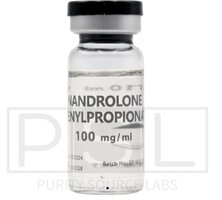- Joined
- Jul 20, 2015
- Messages
- 11,953
- Reaction score
- 5,662
- Points
- 121
What's all the hype with NPP? You become stronger.
It’s not really well-known as a strength booster, but it is part of the benefit package. When you become stronger, you’re able to lift heavier weights and therefore you’re able to build bigger muscles as a result.
It’s great for athletic performance.
If you’re looking for an edge in your sport, then low doses of Nandrolone can help. Even a little Nandrolone can really help with your recovery.
Add a bit more to the Nandrolone decanoate dosage, and you also boost your muscular endurance.
It can be used for the cutting phase.
This is almost a secret among Nandrolone users, but many veterans have recognized this as a viable option for the cutting cycle.
That’s because it offers serious therapeutic relief, which you will tend to need when you’re exercising like and to cut on the fat you gained when you bulked up.
What’s more, it helps your body retain the lean tissue you’ve gained during the bulking phase so that you can focus on burning off fat during the cutting phase.
Boost your red blood cell count.
This is why it’s also used for patients with anemia. This is important for your workout because red blood cells carry oxygen to the various parts of your body, including your muscles.
The job of these cells also involves taking away the carbon dioxide from the blood into the lungs, so that you can exhale it off. Basically, this will help preserve your strength as well as your breath when you work out with great intensity.
It boosts your bone mineral content.
This makes your bones denser, and thus it becomes safer for you to lift heavier weights.
Primary Use: NPP’s calling card is its ability to build mass & strength without initiating severe androgenic side effects. Sure, one could choose to skip NPP altogether and instead blast large dosages of testosterone in their pursuit of muscle mass…and save money doing it…but for the many individuals who need to consider the appearance of their hair and skin, that course of action in not an option. Enter NPP. Nandrolone can be used in place of testosterone (although a replacement dose of test is wise, in order to avoid sexual dysfunction), permitting the user to attain a formidable degree of muscle mass…and save their hair and skin while doing it. In fact, many people claim that NPP is the more effective muscle-builder, when compared on a mg to mg basis. Only experience can provide you with that answer, as personal response to AAS can vary widely. Unlike testosterone, which often leads to mental and/or emotional changes, NPP is typically neutral in this regard, which again, can either be viewed as an advantage or disadvantage depending on one’s goals. When trying to determine whether you should include Deca or NPP in your next cycle, there are 4 primary factors you will need to evaluate when making your decision. They are money, water retention, sexual dysfunction, and injection frequency. Deca is no doubt the more cost-effective option, as a 2.5 gram vial of Deca will typically cost about as much as a 1 gram vial of NPP. Deca also has the advantage of a less frequent injection frequency. However, NPP does not cause nearly as much water retention, nor is it as prone to cause sexual dysfunction at equivalent dosages. Aside from these differentiating characteristics, they are very similar in nature.
Anabolic-Androgenic Ratio: 125:37
Aromatizable: Yes. NPP aromatizes, but only to a small degree; about 1/5th that of testosterone.
Progestagenic Activity: Yes.
Methylated: No.
Standard Dosing Range and Cycle Length: NPP is commonly dosed between 300-1,000 mg per week for a period of 8-16 weeks in length. If one is using NPP solely for the alleviation of joint discomfort, a dose of 200-300 mg per week will usually suffice.
Frequency of Administration: NPP is normally injected every other day to 3X per week.

It’s not really well-known as a strength booster, but it is part of the benefit package. When you become stronger, you’re able to lift heavier weights and therefore you’re able to build bigger muscles as a result.
It’s great for athletic performance.
If you’re looking for an edge in your sport, then low doses of Nandrolone can help. Even a little Nandrolone can really help with your recovery.
Add a bit more to the Nandrolone decanoate dosage, and you also boost your muscular endurance.
It can be used for the cutting phase.
This is almost a secret among Nandrolone users, but many veterans have recognized this as a viable option for the cutting cycle.
That’s because it offers serious therapeutic relief, which you will tend to need when you’re exercising like and to cut on the fat you gained when you bulked up.
What’s more, it helps your body retain the lean tissue you’ve gained during the bulking phase so that you can focus on burning off fat during the cutting phase.
Boost your red blood cell count.
This is why it’s also used for patients with anemia. This is important for your workout because red blood cells carry oxygen to the various parts of your body, including your muscles.
The job of these cells also involves taking away the carbon dioxide from the blood into the lungs, so that you can exhale it off. Basically, this will help preserve your strength as well as your breath when you work out with great intensity.
It boosts your bone mineral content.
This makes your bones denser, and thus it becomes safer for you to lift heavier weights.
Primary Use: NPP’s calling card is its ability to build mass & strength without initiating severe androgenic side effects. Sure, one could choose to skip NPP altogether and instead blast large dosages of testosterone in their pursuit of muscle mass…and save money doing it…but for the many individuals who need to consider the appearance of their hair and skin, that course of action in not an option. Enter NPP. Nandrolone can be used in place of testosterone (although a replacement dose of test is wise, in order to avoid sexual dysfunction), permitting the user to attain a formidable degree of muscle mass…and save their hair and skin while doing it. In fact, many people claim that NPP is the more effective muscle-builder, when compared on a mg to mg basis. Only experience can provide you with that answer, as personal response to AAS can vary widely. Unlike testosterone, which often leads to mental and/or emotional changes, NPP is typically neutral in this regard, which again, can either be viewed as an advantage or disadvantage depending on one’s goals. When trying to determine whether you should include Deca or NPP in your next cycle, there are 4 primary factors you will need to evaluate when making your decision. They are money, water retention, sexual dysfunction, and injection frequency. Deca is no doubt the more cost-effective option, as a 2.5 gram vial of Deca will typically cost about as much as a 1 gram vial of NPP. Deca also has the advantage of a less frequent injection frequency. However, NPP does not cause nearly as much water retention, nor is it as prone to cause sexual dysfunction at equivalent dosages. Aside from these differentiating characteristics, they are very similar in nature.
Anabolic-Androgenic Ratio: 125:37
Aromatizable: Yes. NPP aromatizes, but only to a small degree; about 1/5th that of testosterone.
Progestagenic Activity: Yes.
Methylated: No.
Standard Dosing Range and Cycle Length: NPP is commonly dosed between 300-1,000 mg per week for a period of 8-16 weeks in length. If one is using NPP solely for the alleviation of joint discomfort, a dose of 200-300 mg per week will usually suffice.
Frequency of Administration: NPP is normally injected every other day to 3X per week.




